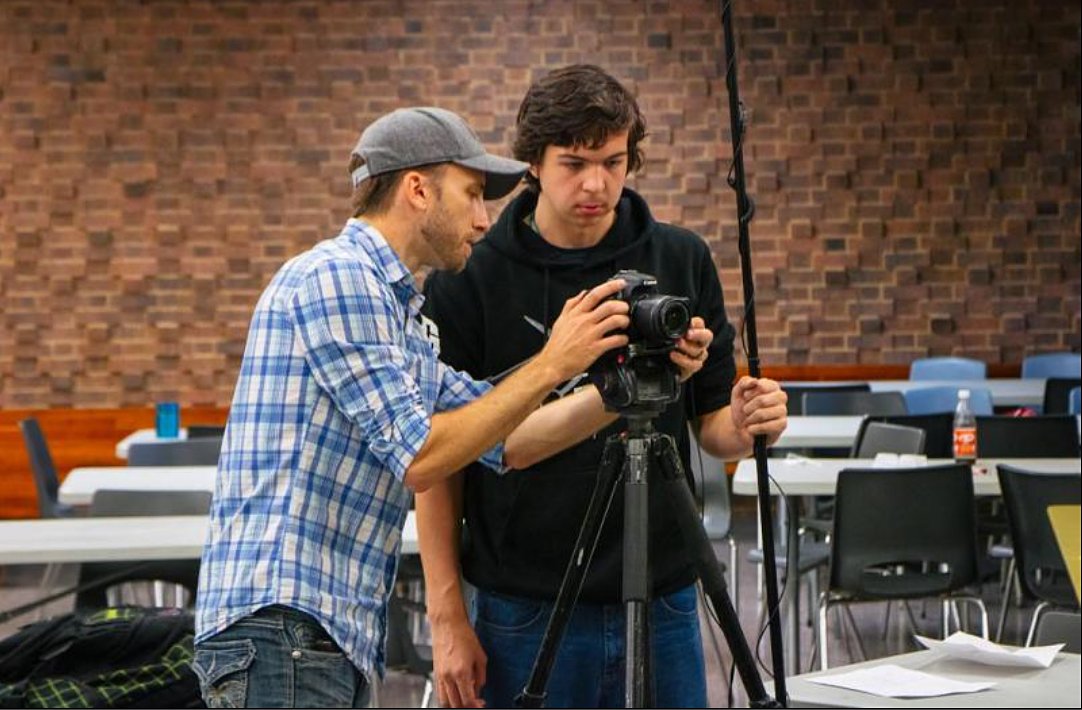Lesson 1: In-Camera Transitions: The Whip Cut
Colin Burwell leads a high school workshop at G.L. Roberts CVI as part of DRIFF EDU. (Photo: Empty Cup Media)
Ready on set? Welcome to DRIFF’s DIY Film School, where we introduce you to some tips and tricks that any aspiring filmmaker can try from the comfort of their home. We’ll guide you through exercises to sharpen your skills as a filmmaker, showing you the basics of what it takes to succeed behind the camera so you can start shooting your own films today.
Lesson 1
In-Camera Transitions: The Whip Cut
One of the biggest challenges you’ll learn to overcome as a new filmmaker is how to transition between scenes. Today, we’ll show you a simple trick to transition from one shot to another, using what’s called a whip cut.
The whip cut is one example of how filmmakers “hide” separate cuts while filming. Directors will strategically end and begin two shots they know can be edited together to give the illusion of filming a single shot, like director Paul Thomas Anderson does here:
A simple way to make an in-camera transition is with a whip pan, which involves rotating your camera very fast to the left or right to create a blurry image for a split second. When Shot A ends with a whip pan and Shot B begins with a whip pan in the same direction, those two shots can appear as one during the editing process. In the space where the camera goes blurry, you’ll be able to hide the cut, making the whole scene flow in one fluid motion.
Here you’ll see it used in practice by Colin Burwell of Empty Cup Media at 2:40 and 3:30:
The whip pan can be a creative way to play with your narrative sense of time, add new energy into your shots, or show a chain of events playing out. Lots of filmmakers use the whip pan to transition between cuts, which you can see more examples of here:
Once you’ve got the idea, let’s try it out! We’ll do a whip cut in-camera transition by filming two shots, then hide the cut between them by editing them together on your phone.
You’ll need:
Smartphone
Video editing software (free editing app like Kinemaster, InShot, or iMovie)
Steps:
1) Using your smartphone held horizontally, film a 5 second static shot (no camera movement) of a wide shot of the room you’re in. At the last half second, quickly pan 90 degrees right to create a blur effect. Stop recording. This is Shot A.
2) Move physically closer to an object that’s in the same room as Shot A. Without pressing record, frame your final composition shot so you know what it looks like, and then pan 90 degrees to your left. Then begin recording. Once the camera is rolling, do a quick pan to the right to create a blur effect. Finish smoothly on a static close up shot of the object and hold that composition for five seconds. Stop recording. This is Shot B.
3) Import Shot A and Shot B into a free editing app.
4) You’ll need to trim the end of Shot A and the beginning of Shot B so that the blur effect you captured in both shots is very quick. Edit them together where the blurry points meet. The two whip pans you recorded should appear as one fluid shot after they’re edited together.
And voila! There you have your very first in-camera transition. Now that you know how it’s done, you can start to experiment with different locations, or play with the depth of your shots, going from close-up to wide angles.
There are plenty of other in-camera transitions out there, but the whip cut is a fun and simple place to start. Try it out and message us on Instagram at @catchthedriff to show us how it turned out!
–
Thank you to Colin Burwell of Empty Cup Media for leading this assignment with his generous support and film knowledge.
Hannah Polinski is a writer, photographer, and filmmaker from Southern Ontario.
—
Interested in becoming part of a local film community or attending a film festival near you? The Durham Region International Film Festival’s events include an annual fall film festival in Durham Region, summer drive-in movie screenings in Whitby and DRIFF in a Jiff short film screenings in Oshawa. Visit driff.ca, become a DRIFF insider or follow us on social media at @catchthedriff for all the details.


